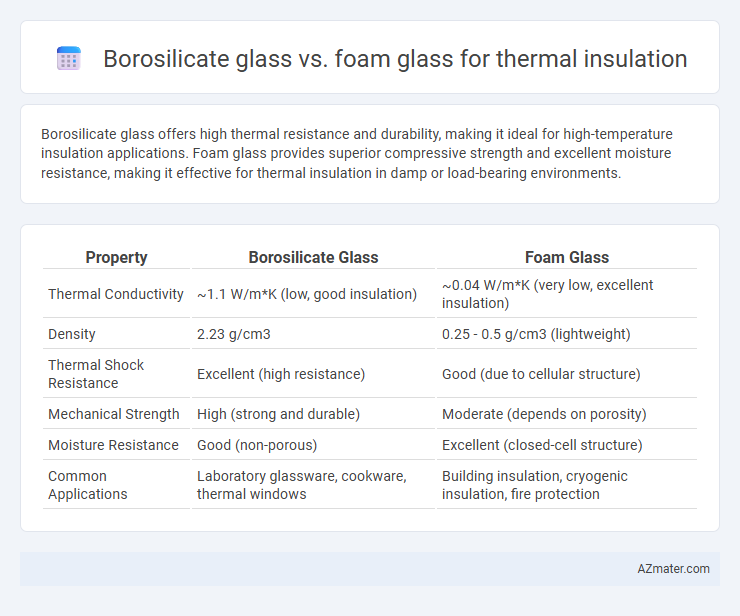Borosilicate glass offers high thermal resistance and durability, making it ideal for high-temperature insulation applications. Foam glass provides superior compressive strength and excellent moisture resistance, making it effective for thermal insulation in damp or load-bearing environments.
Table of Comparison
| Property | Borosilicate Glass | Foam Glass |
|---|---|---|
| Thermal Conductivity | ~1.1 W/m*K (low, good insulation) | ~0.04 W/m*K (very low, excellent insulation) |
| Density | 2.23 g/cm3 | 0.25 - 0.5 g/cm3 (lightweight) |
| Thermal Shock Resistance | Excellent (high resistance) | Good (due to cellular structure) |
| Mechanical Strength | High (strong and durable) | Moderate (depends on porosity) |
| Moisture Resistance | Good (non-porous) | Excellent (closed-cell structure) |
| Common Applications | Laboratory glassware, cookware, thermal windows | Building insulation, cryogenic insulation, fire protection |
Introduction to Thermal Insulation Materials
Thermal insulation materials such as borosilicate glass and foam glass offer distinct properties tailored for energy efficiency. Borosilicate glass excels in high thermal resistance and chemical stability, making it ideal for laboratory insulation and industrial applications. Foam glass provides lightweight, closed-cell structure benefits with superior compressive strength and moisture resistance, widely used in building insulation and cryogenic systems.
What is Borosilicate Glass?
Borosilicate glass is a type of glass composed primarily of silica and boron trioxide, known for its excellent thermal resistance and low coefficient of thermal expansion, making it highly durable under extreme temperature changes. Unlike foam glass, which insulates by trapping air within a cellular structure, borosilicate glass provides thermal insulation through its solid, dense composition that resists heat transfer. Its resistance to thermal shock and chemical corrosion makes borosilicate glass ideal for applications requiring stable insulation performance in high-temperature environments.
What is Foam Glass?
Foam glass is a lightweight, rigid insulation material made from crushed glass that is heated until it foams and solidifies into a closed-cell structure, providing excellent thermal insulation and moisture resistance. Compared to borosilicate glass, which is primarily known for its thermal shock resistance and chemical durability, foam glass excels in thermal insulation due to its low thermal conductivity and inert nature. Foam glass is widely used in industrial applications, roofing, and cryogenics where high compressive strength and non-combustibility are essential.
Thermal Conductivity Comparison
Borosilicate glass exhibits a thermal conductivity typically around 1.1 W/m*K, providing moderate insulation properties ideal for laboratory or cookware applications requiring thermal stability. Foam glass, with its cellular structure, offers significantly lower thermal conductivity values generally between 0.03 and 0.05 W/m*K, making it highly efficient for building insulation and cryogenic storage. The difference in thermal performance arises from foam glass's porous microstructure, which traps air and reduces heat transfer far more effectively than the denser borosilicate glass.
Mechanical Strength and Durability
Borosilicate glass exhibits high mechanical strength and excellent thermal shock resistance, making it ideal for applications requiring durability under rapid temperature changes. Foam glass offers superior compressive strength and exceptional durability against moisture and chemical exposure, enhancing its effectiveness as a long-lasting thermal insulator. Both materials provide robust mechanical integrity, with borosilicate glass favored for thermal shock resilience and foam glass preferred for structural load-bearing insulation.
Chemical and Moisture Resistance
Borosilicate glass offers superior chemical resistance due to its low thermal expansion and high durability against acids and alkalis, making it ideal for corrosive environments. Foam glass provides excellent moisture resistance by being impermeable to water and vapor, preventing mold growth and maintaining insulation performance in damp conditions. Combining borosilicate glass's chemical stability with foam glass's moisture barrier properties results in effective thermal insulation solutions for harsh industrial applications.
Fire and Heat Resistance Properties
Borosilicate glass exhibits exceptional thermal stability with a high melting point around 820degC, making it highly resistant to thermal shock and fire, ideal for applications requiring sustained heat exposure. Foam glass offers excellent fire resistance due to its non-combustible nature and closed-cell structure, maintaining insulation performance even at temperatures exceeding 600degC. Both materials provide superior thermal insulation, but borosilicate glass excels in extreme heat scenarios, while foam glass combines fire resistance with lightweight and moisture-resistant advantages.
Environmental Impact and Sustainability
Borosilicate glass offers excellent thermal insulation with high durability and resistance to thermal shock, and its production involves lower energy consumption compared to traditional glass, contributing to reduced carbon emissions. Foam glass insulation, made from recycled glass, excels in sustainability by emphasizing circular economy principles and providing superior insulating properties with minimal environmental footprint due to its reuse of industrial waste materials. Both materials support eco-friendly construction, but foam glass outperforms in terms of recycled content and end-of-life recyclability, making it a more sustainable choice for green building projects.
Cost and Installation Considerations
Borosilicate glass offers excellent thermal insulation with higher durability but tends to have a higher initial cost compared to foam glass. Foam glass insulation provides lightweight, moisture-resistant properties and easier installation due to its rigid, block form, often resulting in lower labor costs. When choosing between the two, foam glass is typically more cost-effective for large-scale projects requiring quick installation, while borosilicate glass suits applications demanding superior thermal stability and chemical resistance.
Choosing Between Borosilicate and Foam Glass
Borosilicate glass offers superior thermal shock resistance and a higher operating temperature range up to 450degC, making it ideal for applications requiring durability under rapid temperature changes. Foam glass excels in thermal insulation with low thermal conductivity around 0.04 W/m*K and excellent compressive strength, suitable for structural insulation and moisture resistance in construction. Choosing between borosilicate and foam glass depends on whether the priority is thermal shock durability and clarity or lightweight, moisture-resistant insulation with load-bearing capacity.

Infographic: Borosilicate glass vs Foam glass for Thermal insulation
 azmater.com
azmater.com